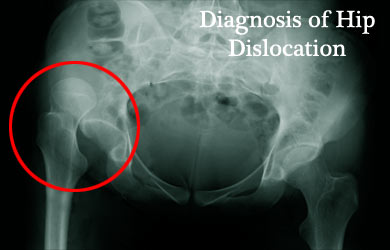- Hip Dislocations - (http://www.patient.co.uk/doctor/hip-dislocations#)
- About Hip Dislocation - (http://orthoinfo.aaos.org/topic.cfm?topic=a00352)
What is Hip Dislocation?
A hip dislocation takes place when the head of the thigh bone is forced out of its socket in the pelvic bone.
The hip comprises of a ball-and-socket joint. The acetabulum, or the socket, is a part of the pelvic bone. The ball is the head or the upper end of the thighbone (femur). Both the ball and the socket are covered by an articular cartilage which creates a friction-free surface for the pelvic bone and the thigh bone to glide across each other during movements at the joint.

A hip dislocation is a painful and serious medical emergency requiring immediate medical attention. In many cases, the soft tissues that hold the bones together and the nerves surrounding the hip are also damaged.
Types of Hip Dislocations
The following are the types of hip dislocations:
- Posterior dislocation. This type of dislocation is the most common, accounting for approximately 90% of all hip dislocations. Here, the femur is pushed out of its socket in a backwards direction.
- Anterior dislocation. This type of dislocation is much less common. Here, the thighbone is pushed out of its socket in a forward direction.
- Central dislocation of the hip. Here, the head of the femur bone goes through the acetabulum. The degree of leg deformity depends on the extent of penetration of the femur bone.
Causes of Hip Dislocation
- Typically, hip dislocation is a traumatic injury that occurs as a result of a huge force either during motor vehicle accidents or due to a fall.
- Hip dislocations arising from developmental problems, such as dysplasia of the acetabulum or the femur head, can also occur.
Symptoms of Hip Dislocation
Symptoms associated with hip dislocation include:
- Severe pain in the hip region
- Inability to move the leg
- Injuries to other parts of the body may also be present that are caused by the trauma
Symptoms may also occur due to immediate or delayed complications of the dislocation. Some of the complications from hip dislocations include:
- Nerve injury, especially of the sciatic nerve which runs from the lower back down behind the leg, which can cause weakness in the legs.
- Osteonecrosis - If blood vessels are damaged, it can stop blood supply to the bones of the hip joint resulting in osteonecrosis, a painful condition that can ultimately result in the destruction of the hip joint.
- Arthritis - The protective cartilage covering the hip bone can be damaged leading to arthritis.

- Recurrent dislocation can occur in those who have had a hip dislocation due to weakened surrounding tissues.
Diagnosis and Treatment of Hip Dislocation
A hip dislocation is a medical emergency and requires immediate medical attention. To begin with, the injured person must be kept still and taken to a hospital as quickly as possible.
Hip dislocation is diagnosed with the help of physical examination and imaging studies, such as x-rays, to show the exact location of the dislocated bones as well as fractures that accompany the dislocation.
If there are no other injuries besides the dislocation, the bones will be manipulated back into their original position after administering a sedative or under anesthesia. This process is called closed reduction. Open surgery will be required in some cases.

Prognosis of Hip Dislocation
Prognosis of dislocation of the hip depends on the type of dislocation, and also on the occurrence of other fractures and injuries. It takes about 2-3 months for a hip dislocation to heal, though recovery may not be complete in some cases. In case additional fractures are present, it may take longer. Physical therapy is recommended in the later stages of the healing process to ensure adequate functional recovery of the joint.







